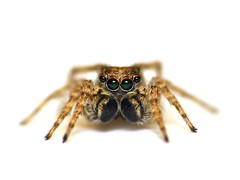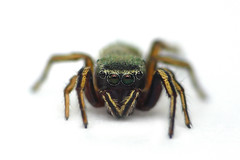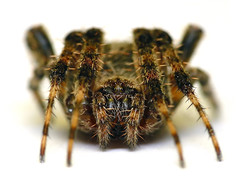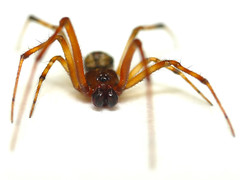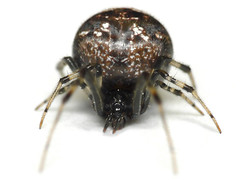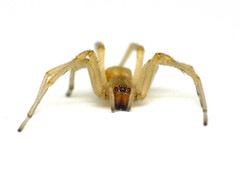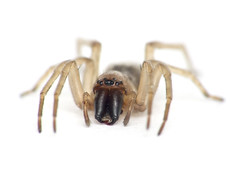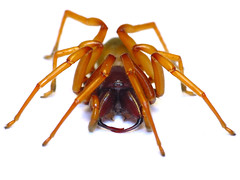 click for large
click for largeI was quite shocked to find this gal crawling around my basement floor. First, it was very large, slightly bigger than a quarter, and second because I could see it's fangs from 6 feet up!
Dysdera crocata is a hunting spider found from New England to Georgia and west to California. It is also a commonly encountered spider in England, northern Europe, and Australia. The Woodlouse Hunter preys on pill bugs or sow bugs (order Isopoda), sometimes beetles, and derives its common name from the British common name for these crustaceans. D. crocata is known to feed on other arthropods as well. This is the only species of the family Dysderidae known to occur in North America.
Unlike 99% of spiders, they have only six eyes, grouped closely together. Their jaws are relatively large, with long fangs for piercing through the hard armor of their prey. These are definitely the longest fangs on any spider I've found in Minnesota. The body of the woodlouse hunter is generally smooth, not hairy. The cephalothorax (front segment) is reddish orange to maroon, and the abdomen is usually tan or grayish white. Males are smaller in size, and their genitalia are visible on the ends of the pedipalps. This is a female.
These spiders hunt at night, actively searching out their prey. Woodlouse hunters do not build webs, but construct small, silken oval-shaped retreats. They overwinter as adults, and after mating in the spring, females deposit about 70 eggs in their retreat. When the young hatch, they stay near the mother for a short period of time.
Raynox DCR-250 mounted on my Panasonic Lumix FZ8.
mounted on my Panasonic Lumix FZ8.
Dysdera crocata is a hunting spider found from New England to Georgia and west to California. It is also a commonly encountered spider in England, northern Europe, and Australia. The Woodlouse Hunter preys on pill bugs or sow bugs (order Isopoda), sometimes beetles, and derives its common name from the British common name for these crustaceans. D. crocata is known to feed on other arthropods as well. This is the only species of the family Dysderidae known to occur in North America.
Unlike 99% of spiders, they have only six eyes, grouped closely together. Their jaws are relatively large, with long fangs for piercing through the hard armor of their prey. These are definitely the longest fangs on any spider I've found in Minnesota. The body of the woodlouse hunter is generally smooth, not hairy. The cephalothorax (front segment) is reddish orange to maroon, and the abdomen is usually tan or grayish white. Males are smaller in size, and their genitalia are visible on the ends of the pedipalps. This is a female.
These spiders hunt at night, actively searching out their prey. Woodlouse hunters do not build webs, but construct small, silken oval-shaped retreats. They overwinter as adults, and after mating in the spring, females deposit about 70 eggs in their retreat. When the young hatch, they stay near the mother for a short period of time.
Raynox DCR-250
